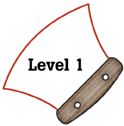|
National Science Education Standards
Objects have many observable properties, including size, weight, shape,
color, temperature, and the ability to react with other substances. Those
properties can be measured using tools such as rulers, balances, and thermometers.
(Page 127)
Objects are made of one or more materials, such as paper, wood, and
metal. Objects can be described by the properties of the materials from
which they are made, and those properties can be used to separate or sort
a group of objects or materials. (Page 127)
|
|
Benchmarks
Objects can be described in terms of the materials they are made of
(clay, cloth, paper, etc.) and their physical properties (color, size,
shape, weight, texture, flexibility, etc.) (Page 76)
Some kinds of materials are better than others for making any particular
thing. Materials that are better in some ways (such as stronger or cheaper)
may be worse in other ways (heavier or harder to cut). (Page 188)
Many of the toys children play with are like real things only in some
ways. They are not the same size, are missing many details, or are not
able to do all of the same things. (Page 268)
A model of something is different from the real thing but can be used
to learn something about the real thing. (Page 268)
|


